This traditional Hungarian recipe is simple, versatile or so comforting with a rich rustic appearance and a smoky sweet flavour of paprika, that is coated over the diced potatoes to make a perfect meal or side dish.
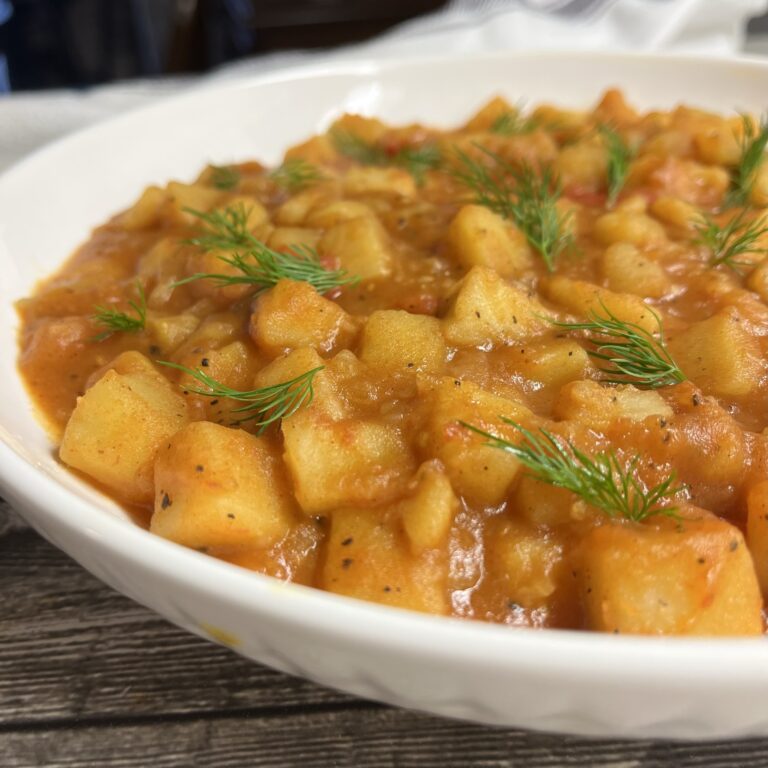
If you have never made this recipe, I highly recommend you give it a try. Serve it with baked or pan-sear fish, pork chops, sausage, roast beef or baked or breaded chicken. As well, this side has been eaten on it’s own with pickles, and sour cream, the Hungarian way. It only takes 30 minutes from start to finish and the outcome is so comforting and delicious.
Did you know? Paprika are rich in antioxidants, and several minerals such as calcium, potassium, magnesium, zinc and phosphorus and vitamins A, C, E, K and B and it is an anti-inflammatory spice. Check out my Nutrition Facts to read more on the benefits of paprika.
- potatoes: I used Yukon gold potatoes, for it’s starch content and other options are russet or white potatoes. Avoid red potatoes as they have the less amount of starch
- extra virgin olive oil or bacon fat
- onion
- Hungarian sweet paprika: is recommended for this recipe, sometimes I will add a little extra for that rich paprika taste and will add 1/4 teaspoon of hot Hungarian paprika but I would recommend to avoid hot if you like it mild.
- seasonings: salt and pepper
- tomatoes: I decided to add tomato into this recipe to balance the rich paprika flavour and tomatoes offer a fresh sweet flavour and colour
- parsley or dill for garnishing
SUGGESTIONS AND TIPS
- Russet potatoes are known to have the most starch. Therefore, I recommend either red potatoes or yellow potatoes as they both are versatile and have the right amount of starch creating a creamy texture.
- I like to use organic potatoes in my recipe for a couple of reasons. The potatoes don’t need to be peeled and potatoes are one of the foods that have the highest pesticide content among the vegetables. Most grocery stores sell organic produce now and the prices have become more reasonable if you compare stores. If you are on a budget, maybe purchase every now and then to reduce the pesticide intake.
- I recommend using Hungarian sweet paprika for this recipe. Hungarian paprika is rich with a smoky hint of flavour. To really get the true flavours of any Hungarian recipe that calls for paprika, using their own home grown paprika is a must.
HOW TO MAKE THIS DELICIOUS RECIPE
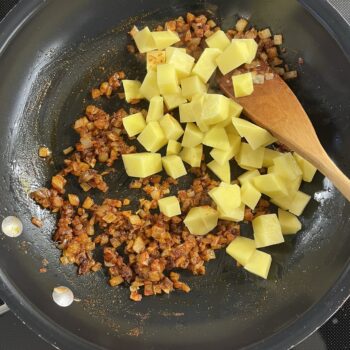
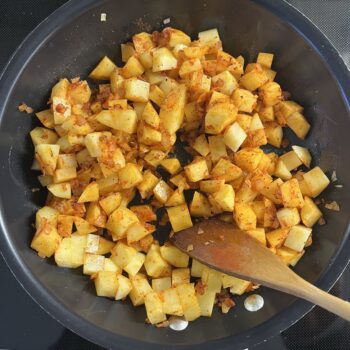
Once the onions are tender then add the paprika and pepper. Stir with the onions and then add the potatoes to the skillet, and stir to combine with the cooked onions, paprika and black pepper. Potatoes should be coated with the spices.
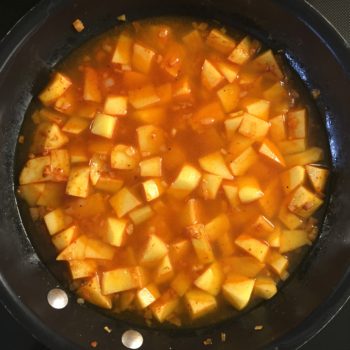
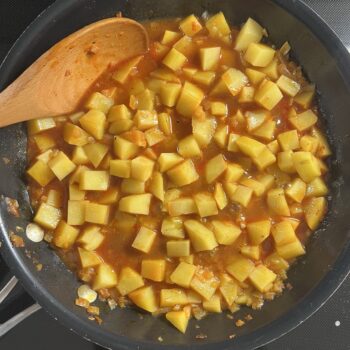
Cover the potatoes with the added water. Bring to a boil then reduce heat to simmer or slow boil for about 30 minutes or until tender. Cover partially with a lid, and the last 10 minutes, add the tomatoes and remove the lid to thicken. Check if additional salt is needed.
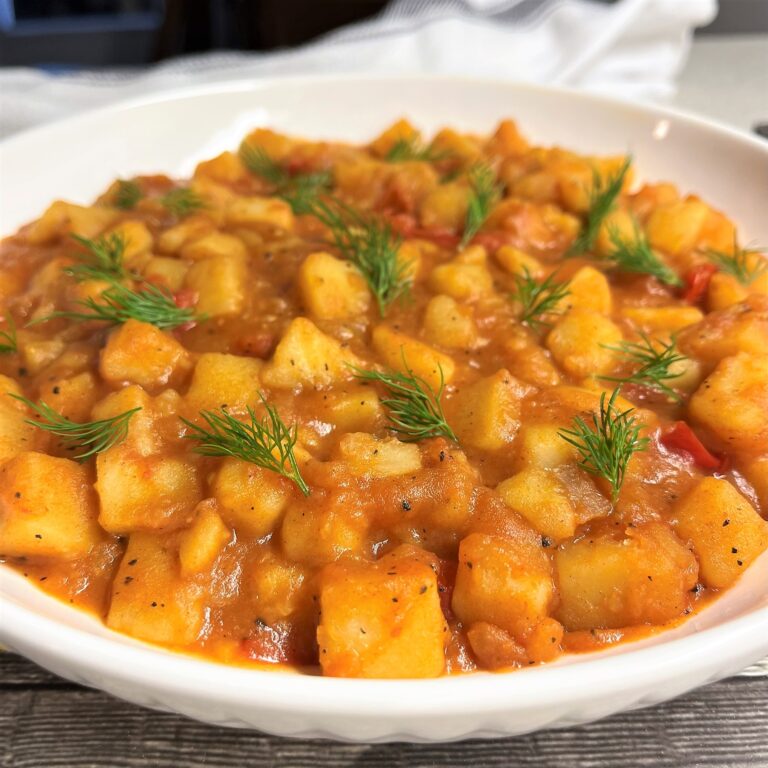
You will notice the creamy texture in this potato dish and that’s from the starch in the potatoes. As you add the water and it cooks, allow the water to evaporate but not completely so you end up with some liquid in the sauce.
If you have never tried these paprika potatoes, you really need to! They are so delicious, even on their own. They are tender with a slight creamy texture and the rich smoky paprika adds so much flavour.
WHAT MAKES THIS DISH SO DELICIOUS
Potatoes are considered to be comfort food and once you add Hungarian sweet paprika to the potatoes, it adds so much flavour and visually it looks so appealing. As they say we eat with our eyes, right?! The onions as well offer a sweetness and it enhances as well as it elevates the flavour in the dish.
I like to add herbs to my dishes for many reasons. They add so much flavour, more specifically earthy flavours with some much aroma when they are fresh. Although, there are many dried herbs that have so much aroma and when you taste them, you swear they are fresh. Dill is one of many herbs that is often added to Hungarian dishes.
Hungarian Paprika Potatoes (Paprikás Krumpli)
RoseEquipment
Ingredients
- 1 lb Yukon gold potatoes, peel and dice (4-5 medium potatoes)
- 2 tbsp extra virgin olive oil
- 1 medium onion, finely chopped
- 2 tsp Hungarian sweet paprika
- ½ tsp black pepper
- ¾ tsp salt
- 1 cup water
- ½ cup tomato, cut into cubes
- garnish, chopped dill or parsley
Instructions
- In a medium-large skillet, over medium heat, add olive oil and sauté onion until tender. Stir in paprika and black pepper.
- Add potatoes to the skillet and stir until the potatoes are coated with the paprika, pepper and onions. Add most of the water to cover the potatoes and bring to a boil, then reduce heat and simmer to a slow boil for 20 minutes. Cover partially with a lid, and once the water has evaporated, add the remaining water and salt. The last 10 minutes, add diced tomatoes and salt, remove the lid to allow it to thicken. The potatoes should be tender and texture should be creamy. Check seasoning before serving.
- Serve with Hungarian sausage, or breaded chicken. Sometimes, this can be a meal in itself, for those who are vegan. Add dill pickles, beets or crusty bread on the side.
Nutrition
Meal Options:
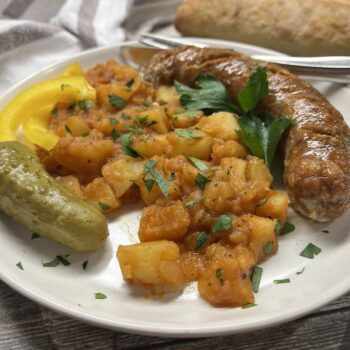
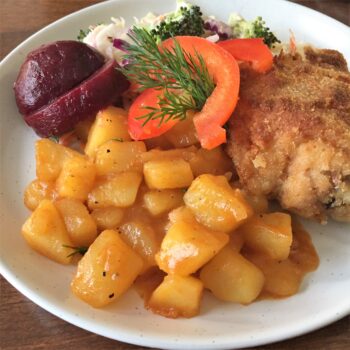
These paprika potatoes are so versatile to add as a side dish with most meats. Often times we would serve these paprika potatoes with breaded chicken or pork, cabbage salad, and canned beets. The flavours really balance each other well. I love the tanginess of the cabbage salad and beets with the paprika potatoes. As well, we always enjoyed these potatoes with Hungarian Kolbasz.





I make these all the time, learned from my Hungarian mother and grandmother. Never tried them with dill on top though. Might be interesting. I generally make them to accompany the chicken pieces from my chicken soup which is the second course.
I also add a little chopped garlic or garlic powder.
Hi Carol,
That sounds delicious! I will have to try!
Thank you,
Rose 🙂
Hi Carol,
Thank you so much for sharing your comment and rating the Hungarian Paprika Potatoes. It’s such a delicious side dish to add to many meat, fish and poultry recipes. Dill is a herb used often in Hungarian dishes. It adds a wonderful freshness to a dish that we so enjoy.
Thank you again,
Rose 🙂
Awesome! Easy to make! Great accompaniment for different meats. Thank you!
Thank you so much Debbie for your rating and comment! I agree, a great recipe to include with your meat dishes.
Rose 🙂